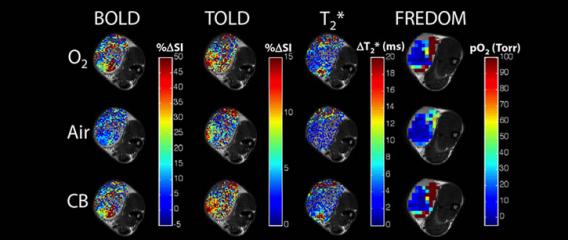
As we enter the age of personalized medicine, it becomes increasingly important to characterize tumors for potential response to therapy. Hypoxia is recognized to influence solid tumor response to therapy and has been related to tumor aggressiveness, including growth, development, and metastatic potential.
Hypoxia is a hallmark of tumor pathophysiology, but its routine non-invasive assessment in vivo remains elusive. Immunohistochemical and invasive electrode studies have revealed tumor hypoxia and its influence on therapeutic response. Non-invasive measurement would be far more attractive and oxygen-enhanced MRI promises insights into tumor hypoxia both for pre-clinical evaluation and ready translation to patients. The ability to stratify patients according to the oxygen characteristics of a tumor becomes increasingly relevant with the development of high dose stereotactic ablation radiation therapy (SABR). We believe we are at a historic juncture, where we not only have technologies for identifying hypoxia, but more importantly methods of tailoring therapy successfully to accommodate or exploit the killing of hypoxic cells.
As a corollary to identifying hypoxia to stratify patients for optimal therapy, there is a pressing need to effectively apply adjuvant interventions to modify response. Historical misanalyses indicate marginal benefit for interventions designed to modify hypoxia, with the general conclusion that success was limited by inability to identify those patients who would benefit.
We have been developing methods to assess tumor oxygenation, which now provide robust validated techniques for pre-clinical assessment of tumor heterogeneity and dynamic response to interventions based on 19F MRI of the reporter molecule hexafluorobenzene. We have recently focused on practical oximetry methods for translation to the clinical arena and focus on oxygen enhanced proton MRI interrogating tissue water itself. Indeed, we have also initiated translation to patients and demonstrate feasibility and relevance in preliminary human applications.
Reference
Oxygenation Imaging by Nuclear Magnetic Resonance Methods. Zhou H, Arias-Ramos N, López-Larrubia P, Mason RP, Cerdán S, Pacheco-Torres J Methods Mol. Biol. 2018 1718 297-313.
Multimodality imaging of hypoxia in preclinical settings. Mason R.P., Zhao D., Pacheco-Torres J., Cui W., Kodibagkar V.D., Gulaka P.K., Hao G., Thorpe P., Hahn E.W., Peschke P., Q J Nucl Med Mol Imaging 2010 Jun 54 3 259-80.
Molecular imaging of hypoxia. Krohn KA, Link JM, Mason RP J. Nucl. Med. 2008 Jun 49 Suppl 2 129S-48S.
Hypoxia: importance in tumor biology, noninvasive measurement by imaging, and value of its measurement in the management of cancer therapy. Tatum JL, Kelloff GJ, Gillies RJ, Arbeit JM, Brown JM, Chao KS, Chapman JD, Eckelman WC, Fyles AW, Giaccia AJ, Hill RP, Koch CJ, Krishna MC, Krohn KA, Lewis JS, Mason RP, Melillo G, Padhani AR, Powis G, Rajendran JG, Reba R, Robinson SP, Semenza GL, Swartz HM, Vaupel P, Yang D, Croft B, Hoffman J, Liu G, Stone H, Sullivan D Int. J. Radiat. Biol. 2006 Oct 82 10 699-757